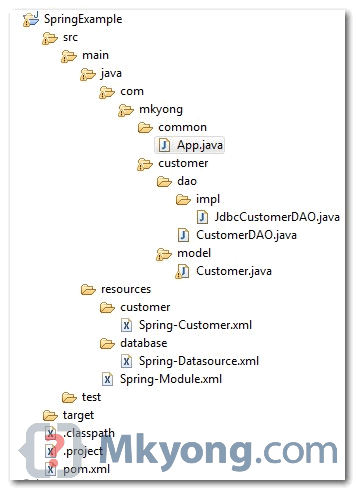Spring + JDBC example
In this tutorial, we will extend last Maven + Spring hello world example by adding JDBC support, to use Spring + JDBC to insert a record into a customer table.
1. Customer table
In this example, we are using MySQL database.
CREATE TABLE `customer` ( `CUST_ID` INT(10) UNSIGNED NOT NULL AUTO_INCREMENT, `NAME` VARCHAR(100) NOT NULL, `AGE` INT(10) UNSIGNED NOT NULL, PRIMARY KEY (`CUST_ID`) ) ENGINE=InnoDB AUTO_INCREMENT=2 DEFAULT CHARSET=utf8;
2. Project Dependency
Add Spring and MySQL dependencies in Maven pom.xml file.
File : pom.xml
<project xmlns="http://maven.apache.org/POM/4.0.0"
xmlns:xsi="http://www.w3.org/2001/XMLSchema-instance"
xsi:schemaLocation="http://maven.apache.org/POM/4.0.0
http://maven.apache.org/maven-v4_0_0.xsd">
<modelVersion>4.0.0</modelVersion>
<groupId>com.mkyong.common</groupId>
<artifactId>SpringExample</artifactId>
<packaging>jar</packaging>
<version>1.0-SNAPSHOT</version>
<name>SpringExample</name>
<url>http://maven.apache.org</url>
<dependencies>
<!-- Spring framework -->
<dependency>
<groupId>org.springframework</groupId>
<artifactId>spring</artifactId>
<version>2.5.6</version>
</dependency>
<!-- MySQL database driver -->
<dependency>
<groupId>mysql</groupId>
<artifactId>mysql-connector-java</artifactId>
<version>5.1.9</version>
</dependency>
</dependencies>
</project>
3. Customer model
Add a customer model to store customer’s data.
package com.mkyong.customer.model;
import java.sql.Timestamp;
public class Customer
{
int custId;
String name;
int age;
//getter and setter methods
}
4. Data Access Object (DAO) pattern
Customer Dao interface.
package com.mkyong.customer.dao;
import com.mkyong.customer.model.Customer;
public interface CustomerDAO
{
public void insert(Customer customer);
public Customer findByCustomerId(int custId);
}
Customer Dao implementation, use JDBC to issue a simple insert and select statement.
package com.mkyong.customer.dao.impl;
import java.sql.Connection;
import java.sql.PreparedStatement;
import java.sql.ResultSet;
import java.sql.SQLException;
import javax.sql.DataSource;
import com.mkyong.customer.dao.CustomerDAO;
import com.mkyong.customer.model.Customer;
public class JdbcCustomerDAO implements CustomerDAO
{
private DataSource dataSource;
public void setDataSource(DataSource dataSource) {
this.dataSource = dataSource;
}
public void insert(Customer customer){
String sql = "INSERT INTO CUSTOMER " +
"(CUST_ID, NAME, AGE) VALUES (?, ?, ?)";
Connection conn = null;
try {
conn = dataSource.getConnection();
PreparedStatement ps = conn.prepareStatement(sql);
ps.setInt(1, customer.getCustId());
ps.setString(2, customer.getName());
ps.setInt(3, customer.getAge());
ps.executeUpdate();
ps.close();
} catch (SQLException e) {
throw new RuntimeException(e);
} finally {
if (conn != null) {
try {
conn.close();
} catch (SQLException e) {}
}
}
}
public Customer findByCustomerId(int custId){
String sql = "SELECT * FROM CUSTOMER WHERE CUST_ID = ?";
Connection conn = null;
try {
conn = dataSource.getConnection();
PreparedStatement ps = conn.prepareStatement(sql);
ps.setInt(1, custId);
Customer customer = null;
ResultSet rs = ps.executeQuery();
if (rs.next()) {
customer = new Customer(
rs.getInt("CUST_ID"),
rs.getString("NAME"),
rs.getInt("Age")
);
}
rs.close();
ps.close();
return customer;
} catch (SQLException e) {
throw new RuntimeException(e);
} finally {
if (conn != null) {
try {
conn.close();
} catch (SQLException e) {}
}
}
}
}
5. Spring bean configuration
Create the Spring bean configuration file for customerDAO and datasource.
File : Spring-Customer.xml
<beans xmlns="http://www.springframework.org/schema/beans" xmlns:xsi="http://www.w3.org/2001/XMLSchema-instance" xsi:schemaLocation="http://www.springframework.org/schema/beans http://www.springframework.org/schema/beans/spring-beans-2.5.xsd"> <bean id="customerDAO" class="com.mkyong.customer.dao.impl.JdbcCustomerDAO"> <property name="dataSource" ref="dataSource" /> </bean> </beans>
File : Spring-Datasource.xml
<beans xmlns="http://www.springframework.org/schema/beans" xmlns:xsi="http://www.w3.org/2001/XMLSchema-instance" xsi:schemaLocation="http://www.springframework.org/schema/beans http://www.springframework.org/schema/beans/spring-beans-2.5.xsd"> <bean id="dataSource" class="org.springframework.jdbc.datasource.DriverManagerDataSource"> <property name="driverClassName" value="com.mysql.jdbc.Driver" /> <property name="url" value="jdbc:mysql://localhost:3306/mkyongjava" /> <property name="username" value="root" /> <property name="password" value="password" /> </bean> </beans>
File : Spring-Module.xml
<beans xmlns="http://www.springframework.org/schema/beans" xmlns:xsi="http://www.w3.org/2001/XMLSchema-instance" xsi:schemaLocation="http://www.springframework.org/schema/beans http://www.springframework.org/schema/beans/spring-beans-2.5.xsd"> <import resource="database/Spring-Datasource.xml" /> <import resource="customer/Spring-Customer.xml" /> </beans>
6. Review project structure
Full directory structure of this example.

7. Run it
package com.mkyong.common;
import org.springframework.context.ApplicationContext;
import org.springframework.context.support.ClassPathXmlApplicationContext;
import com.mkyong.customer.dao.CustomerDAO;
import com.mkyong.customer.model.Customer;
public class App
{
public static void main( String[] args )
{
ApplicationContext context =
new ClassPathXmlApplicationContext("Spring-Module.xml");
CustomerDAO customerDAO = (CustomerDAO) context.getBean("customerDAO");
Customer customer = new Customer(1, "mkyong",28);
customerDAO.insert(customer);
Customer customer1 = customerDAO.findByCustomerId(1);
System.out.println(customer1);
}
}
output
Customer [age=28, custId=1, name=mkyong]
Download Source Code
Download it– SpringJDBCExample.zip (10 KB)
郑重声明:本站内容如果来自互联网及其他传播媒体,其版权均属原媒体及文章作者所有。转载目的在于传递更多信息及用于网络分享,并不代表本站赞同其观点和对其真实性负责,也不构成任何其他建议。



































